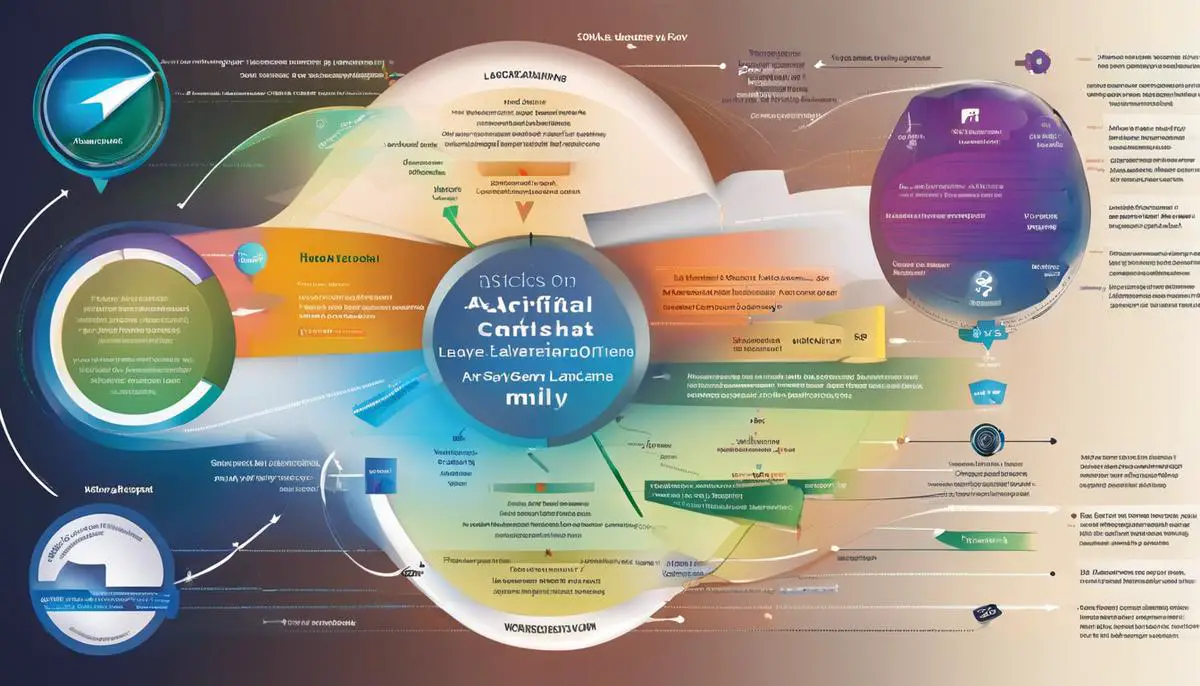In the intricately woven fabric of artificial intelligence, Cross Attention Layers signify an important thread that redefines accuracy and efficiency of machine learning models. Their complex construction and application across diverse fields, from natural language processing to image recognition, sheds light on their pivotal role. As a professional delving into this realm, understanding the essence, design, and optimization of these layers can present an enriching insight into the nuances of their broad-ranging implications. Shrouded in computational complexities, their structure holds the key to enabling more credible and reliable AI systems – a value that’s paramount in the rapidly evolving landscape of technology. This discourse aims to elucidate the basic premise of Cross Attention Layers, their mechanical structure, real-world applications, optimization techniques, and future potential.
Contents
Basics of Cross Attention Layers
Cross-attention layers in deep learning models, specifically in transformer architectures, manifest as a robust, promising area of research. The exploration of their function, use, and potential applications showcase the dynamic world of artificial intelligence (AI) and natural language processing (NLP), revealing the depth of transformative computation possibilities.
One must understand the basics of transformer models to grasp the intricacies of cross-attention layers. Transformers, at their essence, are a class of deep learning models introduced by Vaswani et al., in the seminal paper “Attention is All You Need” in 2017. They are designed to handle sequential data while considering global context, unlike Recurrent Neural Networks (RNN) and Convolutional Neural Networks (CNN) which rely on local context.
Now, within transformers, the fundamental unit is an attention mechanism. This mechanism allows the model to weigh the importance of each input when generating a particular output. The attention mechanism is presented in two main forms in the context of transformers – self-attention and cross-attention.
Self-attention, as the name suggests, allows each token in the input sequence to attend to all other tokens, permitting better understanding of the context. Cross-attention, on the other hand, allows a query from one sequence to interact with a different key-value pair from another sequence.
Deeply examining cross-attention layers illuminate their purpose effectively. Deployed diligently within the transformer model, they serve as bridges, creating connections between different sequences. They allow the model to ‘learn’ relationship from a sequence (say sequence A- usually the existing input) and apply it to a different sequence (sequence B- such as the output sequence). For example, if the model is generating translations, sequence A might be a sentence in English, and Sequence B could be its translation in French. Due to the cross-attention layer, the model understands the contextual relationship between the English sentence and its French counterpart, making its prediction more accurate.
These layers have shown remarkable performance in tasks such as machine translation, sentiment analysis, and text summarization. With cross-attention, transformer models can use learned knowledge and situational context to enhance predictions and provide better results.
Moreover, in models like GPT-3 and T5, cross-attention is employed in creative ways to further push the performance boundaries in language understanding tasks. They allow these models to generate more coherent and contextually appropriate responses by considering the conversation history – offering a fascinating peek into the potential that cross-attention layers behold.
In essence, cross-attention layers are critical components of the transformer architecture that provide an elegant mechanism to connect distinct sequences, thereby offering the profound ability to contextualize information while dealing with tasks involving different sequences. The ongoing research in this area holds potential to progressively unlock fresh breakthroughs in the dynamic realms of AI and NLP.

Mechanical Construction of Cross Attention Layers
The mechanical engineering of Cross Attention Layers in AI forms a crucial part of the machinery that drives the capabilities of today’s digital world, firmly rooting its position in the realm of cutting-edge technology. These layers, embodying the transformer architectures’ pivotal mechanisms, execute a commendable task of bridging sequences by referring to distinct input and output sequences, rather than limiting the attention scope to a singular sequence. This deviation from the conventional self-attention mechanism engenders remarkable enhancements in performance across various tasks and applications.
A deep exploration into the intricate mechanisms reveals the internal functioning of the cross-attention layers, which are inherently based on the foundational principles of multi-head attention. In the context of transformer architectures, each head, functioning individually, calculates the attention scores for all the positions in the input and output sequences. Once computed, these scores are processed through the softmax function, determining the level of importance assigned to each element within a sequence. Consequently, the output sequence elements are weighted averages of the input sequence, directly corresponding to these scores.
Unquestionably, the process of query-key-value projection plays a critical role in the workings of cross-attention. Each input, passed through different feed-forward networks, is mapped to a trinity of vector spaces: queries, keys, and values. While queries and keys are systematically involved in the computation of attention scores, the values are aggregated, by weighting them based on these scores, to produce the final output. Thus, the mechanism stitches together disparate sequences in a manner akin to navigating through a complex labyrinth to unravel the thread of relevance.
Delving deeper, it becomes apparent how these layers obviate the need for recurrent architectures by addressing the common challenge of long-term dependencies. The proficiency of cross-attention lies in the fact that it dynamically adjusts the attention window, making it conditionally dependent on the input sequence, unlike the fixed size approaches common to most recurrent architectures. This mechanism, meticulously designed, can adapt to varying lengths of dependencies encapsulated within the sequences, a feat that enhances the flexibility and efficiency of AI models.
Finally, while evaluating cross-attention layers, their reach isn’t narrowly confined to GPT-3 or T5 models, but is expanding at an astronomical rate. These layers have found substantial usability in areas pertaining to sequence transduction models and tasks such as machine translation, question answering, and summarisation. As the quest for discovery unfolds, the potential for innovative applications and breakthroughs appears seemingly infinite. This is exemplified by the recent shift of focus to masked language models integrating cross-attention, enabling broader comprehension of complex language structures.
Indubitably, the engineering of cross-attention layers in AI signifies a monumental stride in the pursuit of superior AI capabilities, which, in essence, recreates the human cognitive ability to dynamically allocate attention to pertinent stimuli. This critical aspect of attention-based architectures serves as an indispensable tool, propelling the continuous evolution and understanding of AI.

Application of Cross Attention Layers in AI
Diving deeper into the world of artificial intelligence (AI) and natural language processing (NLP), the workings of Cross-Attention Layers, a significant leap forward in neural network architectures, prove that a closer look is warranted.
Enhanced understanding of these layers allows researchers to develop and implement more complex models, propelling AI technologies forward.
A renowned divergence from usual self-attention mechanisms is genuinely worth the attention. Unlike approaches centered around self-attention, where the model attends to all encoders to generate a decoder’s hidden state, the cross-attention system allows for a focus on an exclusively different input during decoding.
This variation paves the way for information extraction across data types or from multiple sources, a monumental step in creating better understanding and contextual awareness in AI systems.
At the heart of the cross-attention mechanism lie the fundamental workings of query-key-value projections. The salient idea is to calculate attention weights and outputs by comparing the query with respective keys from a different input, given the query and keys are from separate sources. These weights are then used to create a weighted average of values. This framework allows the model to reach out beyond its confines and collect information from a different input sequence.
An added complexity is the concept of multi-head attention, a mechanism that allows the model to focus on different positions of a provided sequence concurrently. In cross-attention, each of these ‘heads’ can gather unique information from contrasting sources, thereby bringing diversity to the underlying knowledge procured, and ultimately an improved, rich context understanding.
The crux of long-term dependencies rests within these cross-attention layers. Neural networks, especially in natural language processing (NLP) capabilities, often struggle to retain and process information from an earlier point if a sequence grows significantly. The dynamism interjected by cross-attention layers distinctly addresses these challenges. With the ability to extract high-quality information from distinct sources, they display an extraordinary ability to maintain relationships between far-off input elements, consequently supporting lengthy sequences.
The push towards innovative applications harnessing cross-attention layers is already evident. The linking of information across layers present within images and text, computer vision models that assemble object relationships within images, and video-processing models that correlate frames are just the tip of the iceberg.
Masked language models have recently started integrating cross-attention layers. This new approach allows AI models to understand masked or partially visible information better by examining the overall sequence’s context. Cross-attention layers are an essential part of this integration for context-sensitive masked language models, like BERT.
Arguably, nothing is so human as our ability to attend our attention. The interplay of neural networks and cross-attention layers emulates this cognitive ability in modeling systems, enabling artificial intelligence to make remarkable strides towards human-like attention and comprehension, driven by the same core principle — to know more, focus on what truly matters.
Artificial Intelligence, with the advent of in-depth and dynamic cross-attention layers, has taken a quantum leap straight towards a future where nuanced language understanding and context awareness are no longer solely human privy. It unearths a realm of possibilities in the broader technological sphere, escalating human creativity and innovation to uncharted degrees.

Optimization and Improvement of Cross Attention Layers
In tuning the efficiency of Cross Attention Layers for high-end AI performance, there are a few promising avenues for intensifying existing methodologies and processing performance. This efficiency enhancement can be achieved via both hardware and algorithmic advancements.
On the hardware front, the parallel processing capabilities of GPUs (Graphic Processing Units) can play a decisive role. Given that Cross Attention computation requires vast number of matrix operations, GPU’s parallel processing capabilities help in running these mathematical operations concurrently, notably heightening the performance speed. Newer generations of GPUs can, therefore, significantly augment the efficiency of the Cross Attention Layers.
When addressing algorithmic improvements, significant advancements can be achieved via pruning and quantization. Pruning reduces the size of the AI model, and in turn, the complexity of Cross Attention Layers, by eliminating the less relevant connections. This decreases the total computations required without significantly impacting the model’s performance thereby increasing its efficiency. Quantization is a similar technique that reduces the numerical precision of the weights used in model formation. Reduced precision means less processing power, and thus improved computation efficiency. Both pruning and quantization help in crafting lighter and leaner models that still retain the essential performance characteristics.
Additionally, algorithmic enhancements can also be made by simplifying the computation of the Softmax function, a critical component of Cross Attention Layers. For example, techniques like LogSumExp Scores can be employed to simplify these calculations. The use of Kernelized Attention can also provide an expedited computational pathway and enhance training times.
Moving further along the lines of algorithmic enhancements, efficient caching strategies can also be considered. Caching is an application-independent mechanism that allows the system to rapidly access recently used data. Due to the repetitive usage of certain elements in transformer architectures, caching can considerably reduce the computation time and enhance overall efficiency.
The idea of dynamic computational complexity can also be put into play. At different stages of data processing, not all information carries the same level of relevance. Therefore, adaptive computation time models that allocate computations more flexibly can improve efficiency.
Lastly, the concept of reversible or invertible self-attention mechanisms can reduce memory usage significantly. The prediction across the different stages of decoding can be done independently, thus avoiding redundant processing. This reduction in redundancy paves the way for enhanced efficiency without the loss of performance.
In conclusion, the enhancement of efficiency of Cross Attention Layers is not an easy task. It requires a strategic blend of hardware and software advancements, coupled with intensive research. However, the techniques mentioned herein present a promising potential and point towards a significantly efficient future for AI-optimized Cross Attention Models.

Future Implications of Cross Attention Layers
As we chart the future course of Cross-Attention layers in Artificial Intelligence, it is imperative to recognize the advancements being made in parallel processing capabilities of Graphics Processing Units (GPUs).
GPUs have dramatically accelerated the training of deep learning models, including those that employ cross-attention layers, by efficiently handling high-dimensional data.
The success of GPUs lies in their aptitude for heavy matrix manipulations and large-scale parallel computations, which are integral to the attention mechanism calculations.
In the future, advancements in GPU designs, with more cores and optimized architecture, promise to deliver even faster processing speeds and potentially, greater efficiency in training deep learning models.
Further, researchers are increasingly exploring the potential of techniques like pruning and quantization.
Pruning, the strategic elimination of certain weights in a neural network, can simplify the model structure, thus reducing the computational burden during training and inference.
Meanwhile, quantization reduces the precision of the numerical representations used within the model.
Both techniques are seen as highly promising for facilitating application of cross-attention layers, particularly in devices with low computational power or memory, without significantly compromising the model’s accuracy.
To this end, researchers are also developing methods to simplify the computation of the Softmax function – a critical component of the attention mechanism that normalizes the weights assigned to different inputs.
Simplification of Softmax computation, by approximation methods, for example, can make cross-attention layers more efficient and adaptable to real-time applications.
Moreover, efficient caching strategies have added reciprocal value to cross-attention layers, enabling models to remember and quickly retrieve already computed attention vectors.
This strategy especially facilitates translation tasks and any related sequence-to-sequence tasks that have significant overlap between consecutive source-target pairs.
Academic discourse has also gravitated towards ‘dynamic computational complexity,’ which pertains to models adjusting their computational requirements based on the complexity of the data, resulting in substantial computational savings.
Conceivably, future implementations of cross-attention layers could adapt the number or depth of layers used based on the inputs, leading to optimized performance.
One of the more innovative directions being taken is the development of reversible or invertible self-attention mechanisms.
Reversible computations allow for the restoration of activations in any layer from those in the subsequent layer, eliminating the need to store intermediate activations and, thus, significantly reducing memory requirements.
This opens the door for training even larger models with long sequences on hardware with limited memory.
In conclusion, cross-attention layers are undeniably a transformative component of AI architecture with potential to shape future advancements.
The upcoming trends indicate a gradual shift towards more efficient, scalable and dynamic attention-based models which can handle increasingly complex tasks while making optimal use of resources.
The future looks promising and it’s a privilege to be a part of this groundbreaking journey.

Immersing into the depth and breadth of Cross Attention Layers opens up new vistas of understanding and appreciation for their role in artificial intelligence. Their intricate design, coupled with the complexity of their application, reflects an undeniable future potential that is impossible to ignore. As we embrace new breakthroughs in optimization and strive for higher performance, the continuous evolution of these layers paints an exciting vista of technological advancements. Envisaging their trajectory, we realize that the future of AI will invariably be shaped by these elements, guiding us to newer paths of discovery and innovation in the ongoing quest for artificial intelligence supremacy.

Emad Morpheus is a tech enthusiast with a unique flair for AI and art. Backed by a Computer Science background, he dove into the captivating world of AI-driven image generation five years ago. Since then, he has been honing his skills and sharing his insights on AI art creation through his blog posts. Outside his tech-art sphere, Emad enjoys photography, hiking, and piano.
